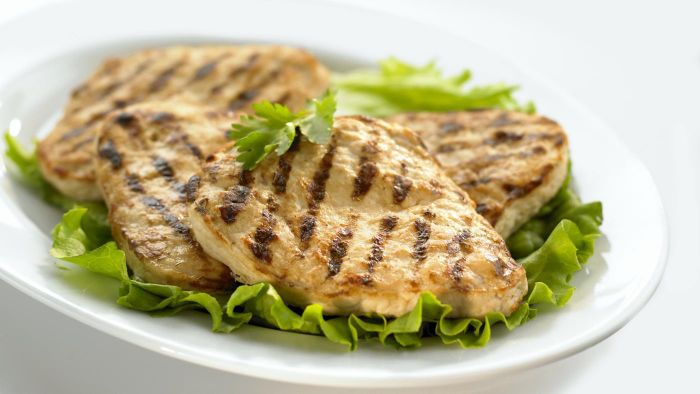When it comes to lean proteins, chicken breast is queen. It offers a whopping 31g of protein per serving, without a lot of fat or kilojoules. Bow down, other proteins. Bow down.
Plus, it’s pretty versatile – you can grill it, roast it, toss it over a green salad, shred and put it into tacos or wraps, or even skewer it and smother it in peanut sauce.
Given that you’re eating it all the time, you’ve probably wondered about chicken breast kilojoules. Is it really as good for you as it seems?
How many kilojoules are in a chicken breast?
Here are the nutrition facts for a 100g serving of roasted chicken breast without the skin:
Kilojoules: 690
Protein: 30g
Fat: 4g
Saturated fat: 1g
Carbohydrates: 0g
Fibre: 0g
Sodium: 74mg
Now consider the differences when you keep the skin on:
Kilojoules: 824
Protein: 30g
Fat: 8g
Saturated fat: 2g
Carbohydrates: 0g
Fibre: 0g
Sodium: 71mg
As you can see, keeping the skin on doubles the fat and saturated fat content, but adds a modest number of kilojoules – about 30. One key thing to remember is that these numbers are for a 100g serving. That’s slightly more than half the average chicken breast.
This is what you’ll get for a whole, boneless, skinless chicken breast:
Kilojoules: 1188
Protein: 53g
Fat: 6g
Saturated Fat: 1.7g
Carbohydrates: 0g
Fibre: 0g
Sodium: 127mg
So if you eat the whole thing, you’ll be getting a LOT more protein – but also way more kilojoules and fat. (Fun fact: Chickens have quadrupled in size since the 1950s, according to research published in the journal Poultry Science.)
Chicken breast nutrition
Chicken breast obviously has a ton of protein. But it also offers 6% of your daily value of iron per 100g serving, which helps your body carry oxygen throughout the body and supports immune system function.
Research also shows that consuming chicken breast is associated with a lower risk of being overweight and developing heart disease and diabetes, per a study in the journal Food & Nutrition Research.
The study authors also noted that chicken breast offers an especially concentrated amount of nutrients, including B vitamins and zinc, for women during pregnancy and breastfeeding. (Good to know whether you’re in that stage of life or not)
So rest assured, chicken is not overrated. Now, all you need to do is nail down the healthiest way to make it and you’ll be set for life.
Fuente: www.health24.com
